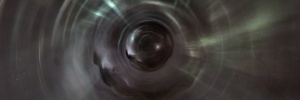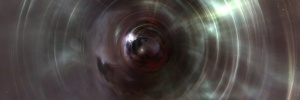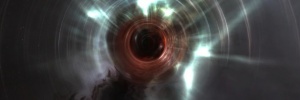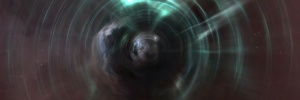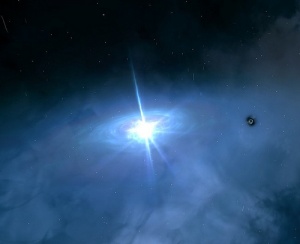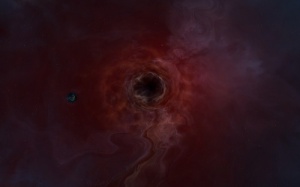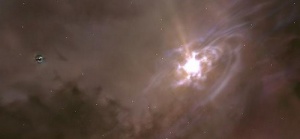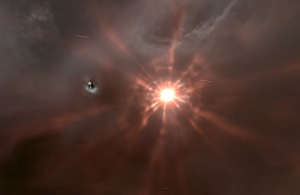A wormhole is a transient portal that allows for travel across vast distances of space. They can be found in every solar system and can lead anywhere from null-sec space to high-sec space. The term wormhole space (alternatively w-space or Anoikis [a name used by Capsuleers and it is believed by many to be Jovian in origin]) describes the unmapped and often dangerous null solar systems accessible through wormholes. Wormholes were introduced with the Apocrypha expansion and gave pilots an extra 2500 solar systems to explore and exploit. To get a basic idea about various wormhole space mechanics, watch Wormhole Fundamentals series on YouTube, found here: http://www.youtube.com/playlist?list=PLBD59459E625C2A27 .
Wormholes - General Information
You can scan down Wormholes from anywhere within New Eden by using the System Scanner (found in the same menu as the Directional Scanner). This is done by fitting a Scan Probe Launcher and loading it with Probes. The results of the probes' findings are read on the System Scanner. For more information about scanning by using probes, see Scanning & Probing.
Wormholes link Known Space (k-space) with Wormhole Space (w-space). K-space includes all the solar systems contained in the Star Map. If you can set a destination to it, a system is k-space, even if it is deep within null-sec space (0.0). Wormholes also link separate w-space solar systems (or pockets). ALL wormholes are randomly placed and are temporary. A given wormhole allows only a certain amount of mass to go through it before it will destabilize and close forever.
Wormhole Space - General Information
There are no Stargates in w-space. Once inside w-space, wormholes are the only way to get from one system to another. If a wormhole closes and you are inside a pocket, there are only two ways to get out:
- Find another WH
- Self-destruct your pod.
The good news is, there's always another wormhole. The moral is, never go into w-space without a scan probe launcher and probes.
W-Space pockets often contain Exploration sites that can be exploited. The sites are always guarded by Sleepers
Wormhole Tactical Information
Any new wormhole you find in w-space may lead to ANYWHERE (even deep 0.0) in Eve. It may also lead to another pocket deeper into w-space (also known as "going deeper down the rabbit hole"). There are often several wormholes into and out of the same w-space solar system, which may be a combination of low-sec, high-sec, 0.0, and other wormhole spaces. If you're lucky, you can occasionally find a wormhole pairing that will let you go between two interesting systems in a couple of jumps.
A wormhole's state will be determined by two factors: Time and Mass. When it spawns, it will be open for a given time, determined by the type of the wormhole, and allow a set amount of mass through. When either variable reaches zero, the wormhole collapses forever. Every time a ship jumps through the wormhole, the mass of the ship (can be seen in the "Show Info" of the ship) will be subtracted from the remaining mass limit of the wormhole. The type of wormhole can be looked up and will tell some basic attributes of the wormhole.
(See Wormhole Size and Stability Information.)
One side of the wormhole will always be the "exit" and is named K162. The "entrance" is the side which was first scanned down and will have the real name of the wormhole.
There are three stages or states in a wormhole's life, which you can get with a 'show info' on the wormhole:
- Not Yet Disrupted (aka Pristine)
- Disrupted But Not Critically (aka Intermediate)
- Critical.
There is a fourth relevant status, which may be displayed below the stage information: "reaching the end of its natural lifetime". This means the wormhole will collapse of old age within four hours or less.
You can tell the state of the wormhole you are about to enter by right-clicking and selecting "Show Info". A pristine wormhole has not yet had 60% of its allotted mass pass through it. An Intermediate wormhole has between 40% and 10% of its allotted mass left. A Critical wormhole has less than 10% of its allotted mass left. Be very sure you want to jump through any Critical wormhole.
When a wormhole spawns, the wormhole is only an entry in your scanner. The destination of that wormhole is not set. The destination is determined randomly the moment the first player warps to the wormhole. When that happens, the corresponding "exit" of the wormhole is spawned in another system and the link between the two systems is established. This can be used to some advantage in gathering information. If you find a wormhole and warp to it, and it is named K162 it means that someone else already found that wormhole from the other side. This can be tactically important -- you know that someone else has visited a K162 wormhole. That means some mass has probably been used, and also that you may have company.
On the other end, if you have just collapsed the last remaining wormhole in a W-Space system and want to be alone for a while, you can scan down and bookmark the newly spawned wormhole, but not warp to it. The link between the systems is never established. However be aware that this will not completely lock other players out, since a new "exit" of another wormhole can spawn at any time in your system.
There are no aggression timers on wormholes. This means that, unlike stargates, you can jump through a wormhole even if you have just initiated combat. However, there is a time limit on sequential jumps through one wormhole.
You can make a maximum of 2 jumps through a wormhole in 4 minutes. If you try to jump a third time through a wormhole inside those 4 minutes, you will receive a message informing you how long you have to wait before you can jump again. Be extremely careful with this if you initiate combat and try to outmaneuver your opponent by jumping repeatedly through a wormhole -- you don't want to end up trapped for four minutes in an unfriendly place.
It's important to note that traditional gatecamps are less effective on a wormhole gate. When jumping through a wormhole gate players will land within jump range (5000m for wormholes) upon reaching the other side. This allows explorers to decloak and bug out of a system after the session change timer should any hostiles appear on d-scan or grid.
Wormhole Space Tactical Information
All W-Space solar systems are null sec (0.0), even the ones you enter from empire. This means anyone can shoot at you at any time with no response from Concord. You're on your own. PvP is only one cloaky ship away whether you want it or not. Prepare accordingly.
Every W-Space system's difficulty is identified through the class of the Wormhole leading to it. The class can range from 1 (easy) to 6 (insanely hard). See Wormhole information sheet below. Another way to identify the W-Space system's class is to look up the Locus Signature of the system in a system database such as: http://www.ellatha.com/eve/WormholeSystemslist.asp
The only way to enter a W-Space system is through wormholes. It is not possible to cyno ships in or out, nor is it possible to clone jump into or out of W-Space.
It is entirely possible to get stuck in W-space. If your Wormhole closes you will have to find another one via scanning. If your scanner ship isn't in W-space with you then you will be stuck and a petition to a GM will NOT get you out. You have two choices if you end up stuck and unable to scan down a Wormhole from within W-Space:
- Self destruct both your ship and your pod.
- Wait until other players come in and hope they are nice enough to gang you and let you warp to them and allow you to leave via the Wormhole they came through. This may take some time.
Consider fitting a probe launcher to your combat ship -- there are around 2500 W-Space systems, so there is plenty of space to get lost in.
W-space can NOT be found in the EVE map, so you will not see where you are. You can however bookmark things the normal way. (And indeed, you should. I have to remind myself that I don't need to bookmark stargates, these days.)
Exploration sites
Every W-Space System can spawn multiple exploration sites which can be scanned down with probes and the System Scanner. These sites are guarded by the remnant drones of the now vanished Sleeper race, which have a much better AI then normal NPCs and can prove to be very difficult opponents.
The sites can be broken down into "cosmic anomalies" and "cosmic signatures". Cosmic Anomalies are the equivalent of K-Space combat sites and can be found without probes via the System Scanner. Just warp to a planet and start the scan. if you don't find one, warp to another planet and repeat the process. Some cosmic anomalies can be heavily guarded, so be careful if you warp to one.
Bringing a Carrier or Dreadnought to a combat site in a Class 4, 5 or 6 Wspace will spawn 6 additional battleships per capital ship. Assigning Fighters to someone who then goes to certain sites will also cause 6 additional battleships to spawn.
For a detailed breakdown of the specific sites found in a Wormhole visit http://eve-survival.org/wikka.php?wakka=WormholeSpace In higher class wormholes additional Sleeper reinforcements may spawn after you have been mining, gas harvesting or salvaging for a time. So be prepared and never go AFK while at a site.
All sites have a maximum life time which seem to range from 24-72 hours after they are found. The despawn timer of a site which has not been not warped to seems to be much higher. If a site despawns, either through completion of the site or expired time, the site will randomly respawn in another system of the same constellation as the W-Space system. This can lead to extreme rich systems where 20 or more cosmic signatures or anomalies are found. The downside of this is that a W-Space system which is farmed over and over again will be nearly barren of signatures and anomalies because the sites will amass in other, unvisited systems.
Wormholes are the exception to this rule. Every W-Space system will have at least one wormhole at any time. If the last wormhole in a W-Space system despawns the "default" wormhole of the system will spawn nearly instantly. This wormhole will mostly be of the same type, i.e. the same mass and time limits, though the destination will be random.
Some W-Space systems will have a "default" wormhole which leads only to other W-Space systems. Those systems, called hubs, will rarely connect to K-Space and can be used for extended W-Space operations.
Cosmic Signatures
Cosmic Signatures need to be probed down. They come in 5 types:
- Gas - These Sites will contain gas clouds, which can be harvested through a Gas Harvester. The gas is needed in Tech 3 production and is lightly guarded. See Gas in W-space for more details on this
- Data - Radar Sites will contain locked containers, containing items like datacores, which can be unlocked through Hacking. Sometimes there will be a Talocan ship wreck, which can be salvaged and will drop ancient hull sections for Tech 3 Ships. The sites are heavily guarded.
- Relic - Those sites will contain ancient relics in containers, which have to be opened through an Analyzer (see Archaeology). Mag Sites are heavily guarded. Ancient relics are needed to generate T3 blueprints through reverse engineering.
- Ore - A grav site contains asteroids which can be mined. In higher class Wormholes the sites can contain enough ore to keep a dozen Hulks busy for days. A grav site can contain every known ore (even Mercoxit) and is lightly guarded. (Huge, huge rocks.)
- Unknown - A unknown site is always another Wormhole and is not guarded by Sleepers, though it may be by players. It is worth noting that while Unknown sites always indicate a Wormhole location, said wormhole will not spawn in its destination system until a player warps to it. While it is by no means a guarantee, avoiding wormhole sites significantly reduces the chance that you will find yourself sharing the system with other players.
POS and W-space
You can use an out of corp alt to anchor a POS in W-Space. However, there are no ice belts in W-Space nor is ice found in the grav sites, which means you have to import all POS fuel from K-Space. A POS, correctly set up, is very hard to destroy in W-Space. In some classes (1 or 2) it would be nearly impossible since the mass limit of the wormholes does not allow enough large ships in. It is not possible to bring Motherships or Titans through a wormhole due to their high mass. If you plan to anchor a POS in a WH system, note that POSs behave as normal except you can not claim Sovereignty and you cannot moon mine. POS presence or absence has no effect on respawn rates, as well.
Though unconfirmed, it is rumored a POS in a class 6 system can attract a Sleeper Dreadnought which will raze the POS (even a DeathStar) to the ground and is extremely tough to defeat. (Who starts these rumors anyway?) The developers have hinted that occupying wormhole space may become more dangerous in future releases.
Wormhole, Wormhole Size and Stability Information
Select sites that provide wormhole information include:
Ellatha (just change the entrance label at the end of the URL)
Staticmapper (just change WH system at end of URL)
The following table shows the wormhole characteristics by looking at the label of a wormhole entrance. To see this label, right click the wormhole on the overview and select, "Show Info." K162 is the generic exit name of a Wormhole; jump to the other side to get the ‘real’ type of the Wormhole.
| Wormhole Type | Leads to | Total Mass Allowed (Kg) | Max Individual Mass (Kg) | Mass Regeneration (Kg/day) | Wormhole Classification | Max Stable Time (Hours) |
|---|---|---|---|---|---|---|
| A239 | Lowsec | 2,000,000,000 | 300,000,000 | 0 | 8 | 24 |
| A641 | Highsec | 2,000,000,000 | 1,000,000,000 | 0 | 7 | 16 |
| A982 | Class 6 W-space | 3,000,000,000 | 300,000,000 | 0 | 6 | 24 |
| B041 | Class 6 W-space | 5,000,000,000 | 300,000,000 | 500,000,000 | 6 | 48 |
| B274 | Highsec | 2,000,000,000 | 300,000,000 | 0 | 7 | 24 |
| B449 | Highsec | 2,000,000,000 | 1,000,000,000 | 0 | 7 | 16 |
| B520 | Highsec | 5,000,000,000 | 300,000,000 | 500,000,000 | 7 | 24 |
| C125 | Class 2 W-Space | 1,000,000,000 | 20,000,000 | 0 | 2 | 16 |
| C140 | Lowsec | 3,000,000,000 | 1,350,000,000 | 0 | 8 | 24 |
| C247 | Class 3 W-space | 2,000,000,000 | 300,000,000 | 0 | 3 | 16 |
| C248 | Nullsec (0.0) | 5,000,000,000 | 1,800,000,000 | 500,000,000 | 9 | 24 |
| C391 | Lowsec | 5,000,000,000 | 1,800,000,000 | 500,000,000 | 8 | 24 |
| D364 | Class 2 W-space | 1,000,000,000 | 300,000,000 | 0 | 2 | 16 |
| D382 | Class 2 W-space | 2,000,000,000 | 300,000,000 | 0 | 2 | 16 |
| D792 | Highsec | 3,000,000,000 | 1,000,000,000 | 0 | 7 | 24 |
| D845 | Highsec | 5,000,000,000 | 300,000,000 | 500,000,000 | 7 | 24 |
| E175 | Class 4 W-Space | 2,000,000,000 | 300,000,000 | 0 | 4 | 16 |
| E545 | Nullsec (0.0) | 2,000,000,000 | 300,000,000 | 0 | 9 | 24 |
| G024 | Class 2 W-Space | 2,000,000,000 | 300,000,000 | 0 | 2 | 16 |
| H121 | Class 1 W-Space | 500,000,000 | 20,000,000 | 0 | 1 | 16 |
| H296 | Class 5 W-Space | 3,000,000,000 | 1,350,000,000 | 0 | 5 | 24 |
| H900 | Class 5 W-Space | 3,000,000,000 | 300,000,000 | 0 | 5 | 24 |
| I182 | Class 2 W-Space | 2,000,000,000 | 300,000,000 | 0 | 2 | 16 |
| J244 | Lowsec | 1,000,000,000 | 20,000,000 | 0 | 8 | 24 |
| K329 | Nullsec (0.0) | 5,000,000,000 | 1,800,000,000 | 500,000,000 | 9 | 24 |
| K346 | Nullsec (0.0) | 3,000,000,000 | 300,000,000 | 0 | 9 | 24 |
| L477 | Class 3 W-Space | 2,000,000,000 | 300,000,000 | 0 | 3 | 16 |
| L614 | Class 5 W-Space | 1,000,000,000 | 20,000,000 | 0 | 5 | 24 |
| M267 | Class 3 W-Space | 1,000,000,000 | 300,000,000 | 0 | 3 | 16 |
| M555 | Class 5 W-Space | 3,000,000,000 | 1,000,000,000 | 0 | 5 | 24 |
| M609 | Class 4 W-Space | 1,000,000,000 | 20,000,000 | 0 | 4 | 16 |
| N062 | Class 5 W-Space | 3,000,000,000 | 300,000,000 | 0 | 5 | 24 |
| N110 | Highsec | 1,000,000,000 | 20,000,000 | 0 | 7 | 24 |
| N290 | Lowsec | 5,000,000,000 | 1,800,000,000 | 500,000,000 | 8 | 24 |
| N432 | Class 5 W-Space | 3,000,000,000 | 1,350,000,000 | 0 | 5 | 24 |
| N766 | Class 2 W-Space | 2,000,000,000 | 300,000,000 | 0 | 2 | 16 |
| N770 | Class 5 W-Space | 3,000,000,000 | 300,000,000 | 0 | 5 | 24 |
| N944 | Lowsec | 3,000,000,000 | 1,350,000,000 | 0 | 8 | 24 |
| N968 | Class 3 W-Space | 2,000,000,000 | 300,000,000 | 0 | 3 | 16 |
| O128 | Class 4 W-Space | 1,000,000,000 | 300,000,000 | 100,000,000 | 4 | 24 |
| O477 | Class 3 W-Space | 2,000,000,000 | 300,000,000 | 0 | 3 | 16 |
| O883 | Class 3 W-Space | 1,000,000,000 | 20,000,000 | 0 | 3 | 16 |
| P060 | Class 1 W-Space | 500,000,000 | 20,000,000 | 0 | 1 | 16 |
| Q317 | Class 1 W-Space | 500,000,000 | 20,000,000 | 0 | 1 | 16 |
| R051 | Lowsec | 3,000,000,000 | 1,000,000,000 | 0 | 8 | 16 |
| R474 | Class 6 W-Space | 3,000,000,000 | 300,000,000 | 0 | 6 | 24 |
| R943 | Class 2 W-Space | 750,000,000 | 300,000,000 | 0 | 2 | 16 |
| S047 | Highsec | 3,000,000,000 | 300,000,000 | 0 | 7 | 24 |
| S199 | Nullsec (0.0) | 3,000,000,000 | 1,350,000,000 | 0 | 9 | 24 |
| S804 | Class 6 W-Space | 1,000,000,000 | 20,000,000 | 0 | 6 | 24 |
| T405 | Class 4 W-Space | 2,000,000,000 | 300,000,000 | 0 | 4 | 16 |
| U210 | Lowsec | 3,000,000,000 | 300,000,000 | 0 | 8 | 24 |
| U319 | Class 6 W-Space | 3,000,000,000 | 1,800,000,000 | 500,000,000 | 6 | 48 |
| U574 | Class 6 W-Space | 3,000,000,000 | 300,000,000 | 0 | 6 | 24 |
| V283 | Nullsec (0.0) | 3,000,000,000 | 1,000,000,000 | 0 | 9 | 24 |
| V301 | Class 1 W-Space | 500,000,000 | 20,000,000 | 0 | 1 | 16 |
| V753 | Class 6 W-Space | 3,000,000,000 | 1,350,000,000 | 0 | 6 | 24 |
| V911 | Class 5 W-Space | 3,000,000,000 | 1,350,000,000 | 0 | 5 | 24 |
| W237 | Class 6 W-Space | 3,000,000,000 | 1,350,000,000 | 0 | 6 | 24 |
| X702 | Class 3 W-Space | 1,000,000,000 | 300,000,000 | 0 | 3 | 24 |
| X877 | Class 4 W-Space | 2,000,000,000 | 300,000,000 | 0 | 4 | 16 |
| Y683 | Class 4 W-Space | 2,000,000,000 | 300,000,000 | 0 | 4 | 16 |
| Y790 | Class 1 W-Space | 500,000,000 | 20,000,000 | 0 | 1 | 16 |
| Z060 | Nullsec (0.0) | 1,000,000,000 | 20,000,000 | 0 | 9 | 24 |
| Z142 | Nullsec (0.0) | 3,000,000,000 | 1,350,000,000 | 0 | 9 | 24 |
| Z457 | Class 4 W-Space | 2,000,000,000 | 300,000,000 | 0 | 4 | 16 |
| Z647 | Class 1 W-Space | 500,000,000 | 20,000,000 | 0 | 1 | 16 |
| Z971 | Class 1 W-Space | 100,000,000 | 20,000,000 | 0 | 1 | 16 |
Classifications of Wormholes
| Class 1, 2 and 3 | This wormhole seems to lead into unknown parts of space. |
| Class 4 and 5 | This wormhole seems to lead into dangerous unknown parts of space. |
| Class 6 | This wormhole seems to lead into deadly unknown parts of space. |
| Class 7 | Highsec Wormhole |
| Class 8 | Lowsec Wormhole |
| Class 9 | Nullsec (0.0) Wormhole |
Wormhole Space Designation
| Class 1 | H121 | P060 | Q317 | V301 | Y790 | Z647 | Z971 | |
| Class 2 | C125 | D364 | D382 | G024 | I182 | N766 | R943 | |
| Class 3 | C247 | L477 | M267 | N968 | O477 | O883 | X702 | |
| Class 4 | E175 | M609 | O128 | T405 | X877 | Y683 | Z457 | |
| Class 5 | H296 | H900 | L614 | M555 | N062 | N432 | N770 | V911 |
| Class 6 | A982 | B041 | R474 | S804 | U319 | U574 | V753 | W237 |
Known Space Designation
| Class 7 High Sec | A641 | B274 | B449 | B520 | D792 | D845 | N110 | S047 |
| Class 8 Low Sec | A239 | C140 | C391 | J244 | N290 | N944 | R051 | U210 |
| Class 9 Null Sec | C248 | E545 | K329 | K346 | S199 | V283 | Z060 | Z142 |
Special Designation
| Wormhole | K162 | This is the exit point of a wormhole that has been entered. |
Fancy Table
from: http://www.tigerears.org/2011/11/14/wormhole-types/
| C1 | C2 | C3 | C4 | C5 | C6 | High | Low | Null | |
|---|---|---|---|---|---|---|---|---|---|
| C1 | H121 | C125 | O833 | M609 | L614 | S804 | N110 | J244 | Z060 |
| C2 | Z647 | D382 | O477 | Y683 | N062 | R474 | B274 | A239 | E545 C248 |
| C3 | V301 | I182 | N968 | T405 | N770 | A982 | D845 | U210 | K346 |
| C4 | P060 | N766 | C247 | X877 | H900 | U574 | |||
| C5 | Y790 | D364 | M267 | E175 | H296 | V753 | D792 | C140 | Z142 |
| C6 | Q317 | G024 | L477 | Z457 | V911 | W237 | D792 | C140 | Z142 |
| High | Z971 | R943 | X702 | M555 | B041 | A641 | R051 | V283 | |
| Low | Z971 | R943 | X702 | N432 | U319 | B449 | N944 | S199 | |
| Null | Z971 | R943 | X702 | N432 | U319 | B449 | N944 | S199 |
Wormholes by Colors
From: http://www.tigerears.org/2011/04/24/wormhole-colours/
See Visually Identifying Wormholes for larger versions.
W-Space Phenomena
Pulsar Phenomena
| Effects | Class 1 | Class 2 | Class 3 | Class 4 | Class 5 | Class 6 |
| Shield | +25% | +44% | +55% | +68% | +85% | +100% |
| Armor Resists | -10% | -19% | -27% | -34% | -41% | -50% |
| Capacitor Recharge Time | -10% | -19% | -27% | -34% | -41% | -50% |
| Targeting Range | +25% | +44% | +55% | +68% | +85% | +100% |
| Signature Radius | +25% | +44% | +55% | +68% | +85% | +100% |
Black Hole Phenomena
| Effects | Class 1 | Class 2 | Class 3 | Class 4 | Class 5 | Class 6 |
| Missile velocity | -10% | -19% | -27% | -34% | -41% | -50% |
| Ship velocity | +25% | +44% | +55% | +68% | +85% | +100 |
| Drone control range | -10% | -19% | -27% | -34% | -41% | -50% |
| Inertia | +25% | +44% | +55% | +68% | +85% | +100% |
| Lock Range | -10% | -19% | -27% | -34% | -41% | -50% |
| Falloff | -10% | -19% | -27% | -34% | -41% | -50% |
Cataclysmic Variable Phenomena
| Effects | Class 1 | Class 2 | Class 3 | Class 4 | Class 5 | Class 6 |
| Armor repair amount | -10% | -19% | -27% | -34% | -41% | -50% |
| Armor remote repair | +25% | +44% | +55% | +68% | +85% | +100% |
| Shield repair amount | -10% | -19% | -27% | -34% | -41% | -50% |
| Shield transfer | +25% | +44% | +55% | +68% | +85% | +100% |
| Capacitor capacity | +25% | +44% | +55% | +68% | +85% | +100% |
| Capacitor Recharge Time | +25% | +44% | +55% | +68% | +85% | +100% |
Magnetar Phenomena
| Effects | Class 1 | Class 2 | Class 3 | Class 4 | Class 5 | Class 6 |
| Damage | +25% | +44% | +55% | +68% | +85% | +100% |
| AOE Velocity | -10% | -19% | -27% | -34% | -41% | -50% |
| Drone Velocity | -10% | -19% | -27% | -34% | -41% | -50% |
| Targeting Range | -10% | -19% | -27% | -34% | -41% | -50% |
| Tracking Speed | -10% | -19% | -27% | -34% | -41% | -50% |
Red Giant Phenomena
| Effects | Class 1 | Class 2 | Class 3 | Class 4 | Class 5 | Class 6 |
| Heat Damage | +10% | +19% | +27% | +34% | +41% | +50% |
| Overload Bonus | +25% | +44% | +55% | +68% | +85% | +100% |
| Smart Bomb Range | +25% | +44% | +55% | +68% | +85% | +100% |
| Smart Bomb Damage | +25% | +44% | +55% | +68% | +85% | +100% |
Wolf Rayet Phenomena
Pronounced "ray-eee"
| Effects | Class 1 | Class 2 | Class 3 | Class 4 | Class 5 | Class 6 |
| Armor Resist | +10% | +19% | +27% | +34% | +41% | +50% |
| Shield Resist | -10% | -19% | -27% | -34% | -41% | -50% |
| Small Weapon Damage | +25% | +44% | +55% | +68% | +85% | +100% |
| Signature Radius | -10% | -19% | -27% | -34% | -41% | -50% |
Wormholes and EVE-University
Due to the nature of the Uni there are some rules regarding exploration of wormholes. During wartime, please refer to the Wartime Standard Operating Procedures. During times of peace, please refer to the Eve University Rules.
EVE University offers Wormhole Campus for students to join and experiment wormhole life. Please refer to the Wormhole Campus page for info on joining requisites and general info about wormholes.








